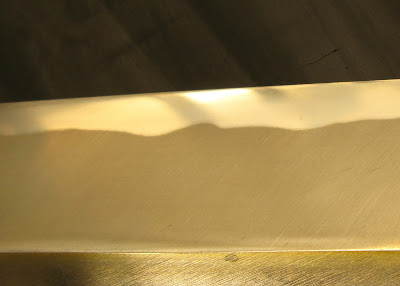This stone is a true mystery to me. Everything I thought I knew about judging the quality of a natural stone came short here. It is large, brute and ugly with a lot of cracks and lines. It is very oddly shaped in a near perfect parallellogram, askew the wrong way to my sharpening angle. Still I love this stone to bits, but why?!
I bought this stone in a batch of very low priced stones from 330mate.com. I paid about a $100 for 6 very different coppa stones planning to use them for Nagura or Uchigumori stones. When I opened the wrapping on this stone I was at first surprised by its large size, but after a small inspection I understood why it was priced so low. The board was full of small hard inclusions, cracks with skin inside which would really mess up my blades, and absolutely packed with lines over the whole board. It looked like crap!
I was about to throw it in the bin at once because I did not believe this could be used for anything or be saved by lapping the surface down. However, before throwing it away, I wanted to feel the grit of the stone and the hardness of the inclusions to see if it could be used as Nagura or maybe Uchigumori stones, so I started lapping it anyway. After just a few minutes grinding away with my #140 grit diamond plate under running water, something started to happen. Fast!
I obviously finished out a dirty layer of the stone. The deepest crack closed in and a lot of the small hard inclusions disappeared with it. I kept on lapping on a new layer. More lines disappeared and the color of the stone changed significantly showing a very strange mixture of colors in one single stone. One side looking and feeling like the red shallow stratum Aka-pin, the centre looking and feeling like a fine Asagi and the other side looking and feeling like a medium hard honsuita. I have never seen anything like it. Three very characteristic stratum in one single stone? There are still some lines and cracks left, but a close inspection and test have shown that they will not scratch.
The typical orange skin often seen on Nakayama stones. Not very pretty, though.
The stone is a multitude of grits and hardnesses. However, it seems like a fairly soft stone overall but with an amazingly fine grit compared to the average hardness. The picture below shows a dense creamy slurry forming after just 30 passes on the stone. The feeling is very delicate, totally without scratcy particles in the slurry. I can hardly believe this stone.
This close up shows an amazingly fine scratch pattern with an almost pefect mist and haze on both Ji and Ha. The slurry of this stone must break down to an extremely fine grit. Compared to my other fine stones I would suggest this to be in the #40000 range, but that's the slurry talking.
Another exeptional feature of this stone is the contrast it makes between Ji and Ha. I have never seen a better contrast from a natural stone. A highly polished edge in contrast to an almost non-reflective blade road. It is really amazing!
The reflective test shows to what high degree this stone polishes. This polished look is actually due to a very fine scratch pattern from the natural stone. Looking at the close up picture above, the surface is actually matte or hazy to the look. This highly complex scratch pattern I believe is one of the main factors to get the edge really sharp and more wear resistant than an edge polished to a full mirror finish by fine synthetic abrasives. You can find some quite interesting reading about this theory here:
http://thejapanblade.com/sharpvsshiny.htm
http://thejapanblade.com/sharpvsshiny.htm
This stone is remarkable! This stone must be the bargain of the century. It is still brute and ugly, full of lines and cracks, but it is really an amazing stone that has thought me to think differently about the looks of a natural stone compared to its qualities.So, what have I learned from this stone? Not to judge by the looks, always give the stone no matter how ugly at least one chance to show itself and finally that treasures can be found in the scraps. Happy hunting!







No comments:
Post a Comment